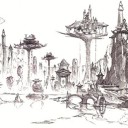神河当時 - 神話の世界
2020年8月11日 Magic: The GatheringIn mid-2002, around the time that development of the Mirrodin set was in full swing, folks in R&D started talking in earnest about Earth (regular readers will remember that the codenames for the Kamigawa block were Earth, Wind, and Fire). Bill Rose had a big idea: he wanted to do a set in which flavor was at least as important as mechanics, maybe more so. I was instructed to think about whether a particular kind of world or flavor would really knock players’ socks off, would excite them as much as some new mechanics.
Back to Reality
At the same time, Bill started getting fond of a particular idea: He wanted to try doing a Magic block that would take place in a world with which players were already familiar. Mirrodin was cool, but it was very “high concept,” and it really pushed the limits of what “fantasy” means. The only constant in Magic is change, so Bill thought maybe we should follow up a strange world with a familiar one. He also thought that doing a setting based on an Earth mythology would inspire card designers because they’d have a flavor basis from which to work.
I won’t lie to you — I disliked the whole idea. I didn’t want to go where other games had already been, and neither did art director Jeremy Cranford. We were proud of Mirrodin, and we knew our illustrators were excited to illustrate our metal world. We wanted to keep going in new directions, and a real-world-inspired setting felt like a step backward. But, see, there’s this thing: Bill Rose is the vice president of R&D. He tends to get his way.
As Mark Rosewater alluded to in his article “Now With Added Flavor,” I evaluated lots of Earth mythologies in an attempt to construct a short list of promising candidates for Bill. Greek? Too mundane, and we have already incorporated a lot of mythical Greek monsters into Magic. Celtic? Aztec? Sumerian? Too obscure. They could be cool, but the vast majority of players wouldn’t be familiar with them, thereby defeating the purpose of doing a real-world-based setting in the first place. Suffice it to say that the eventual list was short, alright. Like four items short.
Bill had found one real-world mythology particularly appealing, but there were some complications. (No, I won’t tell you which, because we’ll likely revisit the idea in the future.) Then something formative occurred. He attended a distributors’ meeting in Tokyo, Japan. When he came back, he had all but made up his mind that we would create a setting based on Japanese mythology.
引用元
A SERIES OF FORTUNATE EVENTS: KAMIGAWA WORLD DESIGN Posted in Feature on October 18, 2004
https://magic.wizards.com/en/articles/archive/feature/series-fortunate-events-kamigawa-world-design-2004-10-18
神河のコンセプトに関する記事です。
まず、Bill Rose副社長の「フレイバー重視でセットを作ろう」というアイデアが発端でした。そこから、地上の神話をベースにする、という方針になります。
ギリシャ神話については、関連したカードがすでに登場していたため没になりました。アステカ神話ではなじみがありません。そこで、ちょうどよい距離感だった日本神話が選ばれたということです。
もっとも、ギリシャ神話も、(神話というより文明ですが)アステカも、モチーフとした世界が後に作られるわけですが。最初からそれらを選んでいた場合、どうなっていたのかは気になります。少なくともギリシャ神話であれば、大外れになることは考えにくいでしょう。
2021/03/09 追記
日本語訳を見つけました。
一連の幸運:神河世界のデザイン――神河の巨大な世界の創造
https://web.archive.org/web/20041113050558/http://www.hobbyjapan.co.jp/magic/articles/files/20041025_01.html


コメント